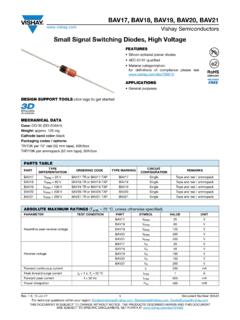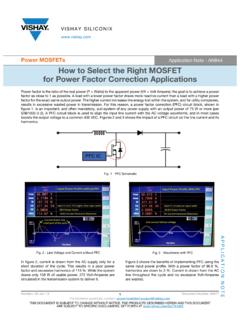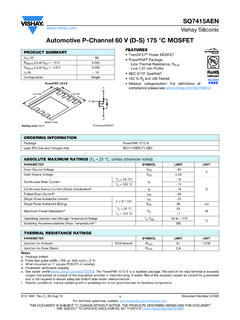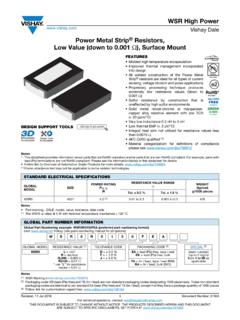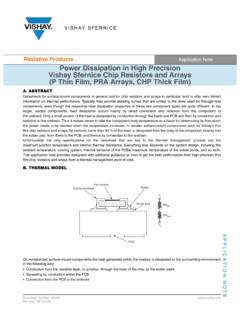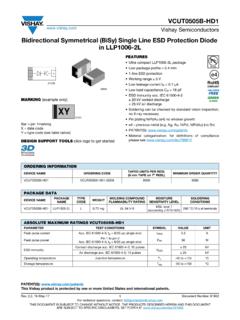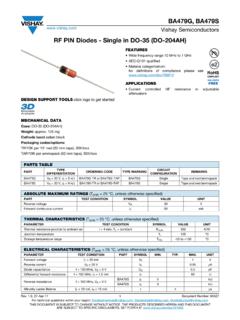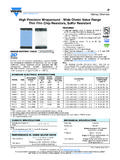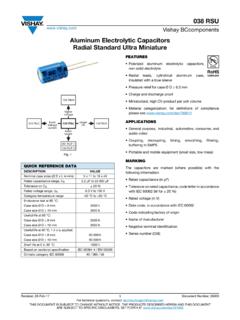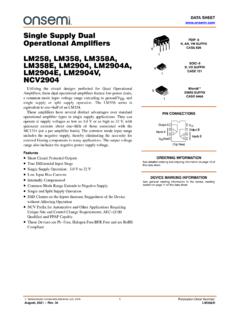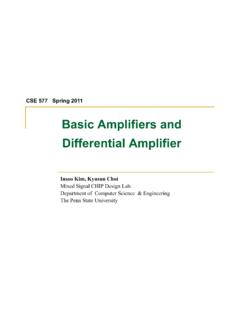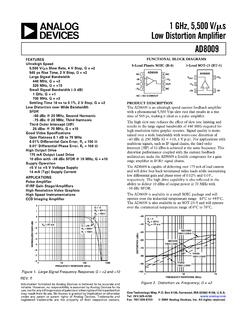Transcription of Physical Explanation - Vishay Intertechnology
1 Vishay GENERAL SEMICONDUCTORR ectifiersApplication NotePhysical ExplanationAPPLICATION NOTE Revision: 16-Aug-111 Document Number: 84064 For technical questions within your region: DOCUMENT IS SUBJECT TO CHANGE WITHOUT NOTICE. THE PRODUCTS DESCRIBED HEREIN AND THIS DOCUMENTARE SUBJECT TO SPECIFIC DISCLAIMERS, SET FORTH AT TERMINOLOGYS emiconductor diodes are used as rectifiers, switches,varactors and voltage stabilizers (see Zener data book).Semiconductor diodes are two-terminal solid-state deviceshaving asymmetrical voltage -current characteristics. Unlessotherwise stated, this means a device has single pn-junctioncorresponding to the characteristics shown in figure 1. Fig. 1 An application of the voltage current curve is given bywhereIf the diode is forward-biased (anode positive with respectto cathode), its forward current (I = IF) increases rapidly withincreasing voltage .
2 That is, its resistance becomes very the diode is reverse-biased (anode negative with respectto cathode), its reverse current (-I = IR) is extremely low. Thisis only valid until the breakdown voltage VBR has beenreached. When the reverse voltage is slightly higher than thebreakdown voltage , a sharp rise in reverse current resistanceResistance of the bulk material between junction and thediode resistance, rPDiode resistance resulting from HF rectification which actsas a damping resistance to the pre-tuned resistanceSee forward resistance, differentialDiode capacitance, CDTotal capacitance between the diode terminals due to case,junction and parasitic voltage , VBRR everse voltage at which a small increase in voltage resultsin a sharp rise of reverse current.
3 It is given in the technicaldata sheet for a specified voltage , VFThe voltage across the diode terminals which results fromthe flow of current in the forward current, IFThe current flowing through the diode in the direction oflower resistance, rFThe quotient of DC forward voltage across the diode and thecorresponding DC forward resistance, differential rfThe differential resistance measured between the terminalsof a diode under specified conditions of measurement, ,for small-signal AC voltages or currents at a point of forwarddirection V-I capacitance, CcaseCapacitance of a case without a semiconductor time, tavWith certain limitations, absolute maximum ratings given intechnical data sheets may be exceeded for a short time.
4 Themean value of current or voltage is decisive over a specifiedtime interval termed integration time. These mean valuesover time interval, tav, should not exceed the absolutemaximum rectified output current, IFAVThe average value of the forward current when using thediode as a rectifier. The maximum allowable averagerectified output current depends on the peak value of theapplied reverse voltage during the time interval at which nocurrent is flowing. In the absolute maximum ratings, one orboth of the following are given: The maximum permissible average rectified outputcurrent for zero diode voltage (reverse). The maximum permissible average rectified outputcurrent for the maximum value of VRRM during the timeinterval at which no current is IFAV decreases with an increasing value of the reverse voltageduring the interval of no current VVT------1 =ISsaturation current=VTkT q------------temperature potential== Physical ExplanationAPPLICATION NOTEA pplication General Semiconductor Revision: 16-Aug-112 Document Number: 84064 For technical questions within your region: DOCUMENT IS SUBJECT TO CHANGE WITHOUT NOTICE.
5 THE PRODUCTS DESCRIBED HEREIN AND THIS DOCUMENTARE SUBJECT TO SPECIFIC DISCLAIMERS, SET FORTH AT efficiency, rThe ratio of the DC load voltage to the peak input voltage ofan RF resistance, rsThe total value of resistance representing the bulk, contactand lead resistance of a diode given in the equivalent circuitdiagram of variable capacitance capacitance, CJCapacitance due to a pn junction of a diode whichdecreases with increasing reverse voltage , VRThe voltage drop which results from the flow of reversecurrent (through the semiconductor diode).Reverse current, IR (leakage current)The current which flows when reverse bias is applied to asemiconductor resistance, RRThe quotient of the DC reverse voltage across a diode andthe corresponding DC reverse resistance, differential , rrThe differential resistance measured between the terminalsof a diode under specified condition of measurement , forsmall-signal (AC)
6 voltage or currents at a point ofreverse- voltage direction V-I forward current, IFRMThe maximum forward current with sine-wave operation,f 25 Hz, or pulse operation, f 25 Hz, having a duty cycletp/T reverse voltage , VRRMThe maximum reverse voltage having an operatingfrequency f 25 Hz for sine-wave as well as pulse surge forward current, IFSMThe maximum permissible surge current in a forwarddirection having a specified waveform with a short specifiedtime interval ( , 10 ms) unless otherwise specified. It is notan operating value. During frequent repetitions, there is apossibility of change in the device s surge reverse voltage , VRSMThe maximum permissible surge voltage applied in a reversedirection.
7 It is not an operating value. During frequentrepetitions, there is a possibility of change in the device dissipation, PVAn electrical power converted into heat. Unless otherwisespecified, this value is given in the data sheets underabsolute maximum ratings, with TA = 25 C at a specifieddistance from the case (both ends).Switching on CharacteristicForward recovery time, tfrThe time required for the voltage to reach a specified value(normally 110 % of the steady state forward voltage drop),after instantaneous switching from zero or a specifiedreverse voltage to a specified forward biased condition(forward current).This recovery time is especially noticeable when highercurrents are to be switched within a short time.
8 The reasonis that the forward resistance during the turn-on time couldbe higher than the DC current (inductive behavior). This canresult in the destruction of a diode because of highinstantaneous power loss if constant current control is on transient peak voltage , VfpThe voltage peak (overshoot) after instantaneous switchingfrom zero or a specified reverse voltage to a specifiedforward biased condition (forward current). The forwardrecovery is very important especially when higher forwardcurrents must be switched on within a very short time(switching on losses). Fig. 2 Fig. 3 Switching off Characteristic, Inductive LoadReverse recovery time, trrThe time required for the current to reach a specified reversecurrent, iR (normally % of IRM), after switching from aspecified forward current IF to a specified reverse biasedcondition (reverse voltage VBatt) with a specified %110 %VFPtfrPhysical ExplanationAPPLICATION NOTEA pplication General Semiconductor Revision: 16-Aug-113 Document Number: 84064 For technical questions within your region: DOCUMENT IS SUBJECT TO CHANGE WITHOUT NOTICE.
9 THE PRODUCTS DESCRIBED HEREIN AND THIS DOCUMENTARE SUBJECT TO SPECIFIC DISCLAIMERS, SET FORTH AT reverse recovery current, IRMThe peak reverse current after switching from a specifiedforward current IF to a specified reverse biased condition(reverse voltage VR) with a specified switching slope reverse recovery is very important especially whenswitching from higher currents to high reverse voltage withina very short time (switching off losses). Fig. 4 Fig. 5 Reverse avalanche energy, ERThe reverse avalanche energy when using the rectifier as afreewheeling diode with an indicutive load. When theinductance is switched off, the current through theinductance will keep on flowing through the until thestored energy,is dissipated within the rectifier.
10 Under this condition thediode is in a reverse avalanche mode with a reverse currentat the beginning which is equal to the current that wasflowing through the inductance just before it was reverse energy capability depends on the reversecurrent and the junction temperature prior to the avalanchemode. Fig. 6 Fig. 7 Switching off Characteristic, Instantaneous SwitchingReverse recovery time, trrThe time required for the current to reach a specified reversecurrent, iR (normally A), after instantaneous switchingfrom a specified forward current IF (normally A) to aspecified reverse current IR (normally A).Reverse recovery charge, QrrThe charged stored within the diode when instantaneousswitched from a specified forward current IF (normally A)to a specified reverse current IR (normally A).

